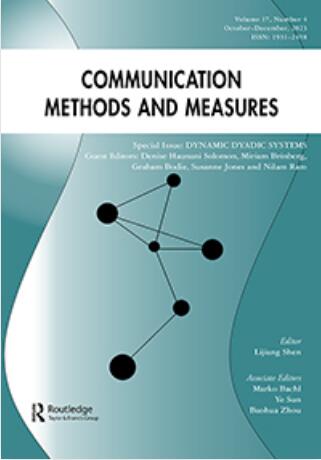研究在线媒体使用的自动跟踪方法:批判性评论和建议
IF 3.7
1区 文学
Q1 COMMUNICATION
引用次数: 26
摘要
摘要随着网络信息环境的日益重要,研究人员开始研究网络媒体使用的直接测量方法,如在线跟踪。到目前为止,大多数使用跟踪数据的现有研究都依赖于商业解决方案,但这些解决方案在成本、可复制性和对某些研究问题的适用性方面存在局限性。因此,不同的研究小组正在为学术目的开发自己的跟踪解决方案。在本文中,我们对现有方法进行了批判性的回顾和分类,以指导关于适当跟踪方法和工具的研究决策。首先,我们制定标准来区分不同的以用户为中心的桌面和移动跟踪方法和工具(信息类型、技术复杂性、隐私实施、用户体验和可用性)。其次,我们用具体的例子描述了不同的工具和方法,分别用于桌面和移动跟踪,并使用上述标准对其进行评估。最后,我们讨论了不同的移动和桌面跟踪解决方案如何相互补充,并为未来的研究提供建议。本文章由计算机程序翻译,如有差异,请以英文原文为准。
Automated Tracking Approaches for Studying Online Media Use: A Critical Review and Recommendations
ABSTRACT With the increasing importance of online information environments, researchers have started investigating direct measures of online media use, such as online tracking. Most existing studies using tracking data have so far relied on commercial solutions, but these have limitations in terms of their costliness, replicability, and applicability to certain research questions. Hence, different research groups are developing their own tracking solutions for academic purposes. In this paper, we provide a critical review and classification of the existing approaches, apt to guide research decisions on the appropriate tracking approach and tool. First, we develop criteria to distinguish different user-centric desktop and mobile tracking approaches and tools (types of information, technical complexity, privacy implementation, user experience, and availability). Second, we describe different tools and approaches – separately for desktop and mobile tracking – with concrete examples and evaluate them using the aforementioned criteria. Finally, we discuss how different mobile and desktop tracking solutions can complement each other and provide recommendations for future research.
求助全文
通过发布文献求助,成功后即可免费获取论文全文。
去求助
来源期刊

Communication Methods and Measures
COMMUNICATION-
CiteScore
21.10
自引率
1.80%
发文量
9
期刊介绍:
Communication Methods and Measures aims to achieve several goals in the field of communication research. Firstly, it aims to bring attention to and showcase developments in both qualitative and quantitative research methodologies to communication scholars. This journal serves as a platform for researchers across the field to discuss and disseminate methodological tools and approaches.
Additionally, Communication Methods and Measures seeks to improve research design and analysis practices by offering suggestions for improvement. It aims to introduce new methods of measurement that are valuable to communication scientists or enhance existing methods. The journal encourages submissions that focus on methods for enhancing research design and theory testing, employing both quantitative and qualitative approaches.
Furthermore, the journal is open to articles devoted to exploring the epistemological aspects relevant to communication research methodologies. It welcomes well-written manuscripts that demonstrate the use of methods and articles that highlight the advantages of lesser-known or newer methods over those traditionally used in communication.
In summary, Communication Methods and Measures strives to advance the field of communication research by showcasing and discussing innovative methodologies, improving research practices, and introducing new measurement methods.
 求助内容:
求助内容: 应助结果提醒方式:
应助结果提醒方式:


